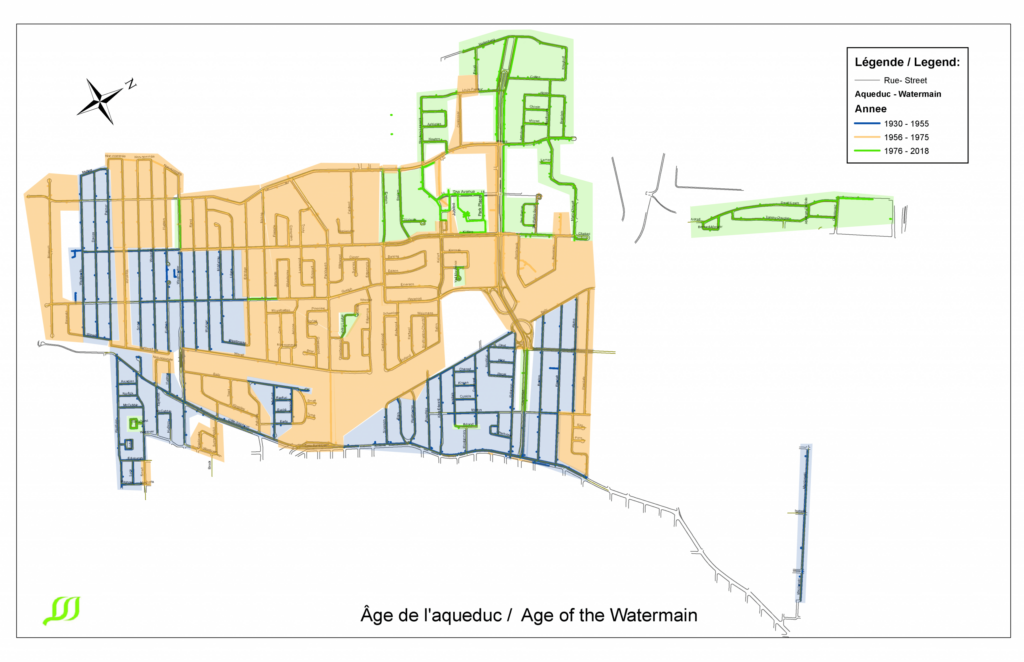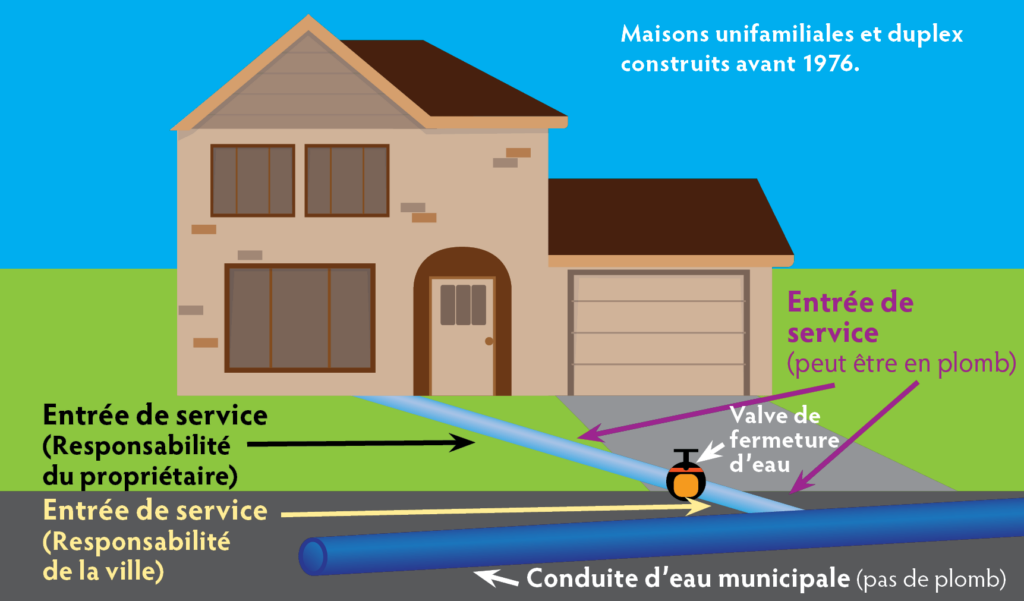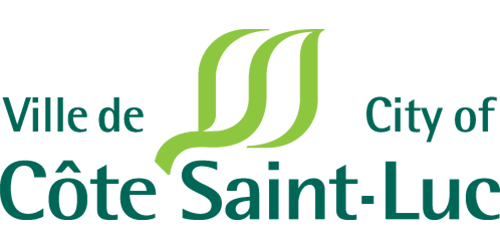Information for homeowners and residents
Côte Saint-Luc took over responsibility for water in 2006. It has been testing and monitoring for lead according to Quebec government standards and protocols since 2013.
Contents
- Action plan
- Our progress so far
- Information about water service pipes
- Lead in drinking water: public health perspective (recommendations)
- The water network from the filtration plant to your tap
Background
The Government of Quebec regulates the quality of drinking water and sets the standards. For decades, the maximum standard for lead content in drinking water was 50 parts per billion (ppb). In 2001, to minimize the public’s exposure to lead, the standard for maximum acceptable lead content was revised from 50ppb to 10ppb.
In March 2019, Health Canada changed the recommended standard from 10 to 5 µg/L. The Québec government was the first in Canada to adopt this new standard, which is one of the strictest in North America.
As a result of this change, there is a need to expedite the removal of the remaining public water service pipes made of lead, as well as to encourage homeowners to replace the private section of the water service pipes made of lead.
The City is responsible for replacing the public section, and homeowners are responsible for replacing the private section. For more details, view By-Law 2594 (PDF).
Action plan
1. Water filters
The City of Côte Saint-Luc provides two rebates water filters to eligible single-family homes and duplexes built before 1976.
- A one-time rebate of up to $200 towards the purchase and installation of an under-sink water filtration system, or a one-time rebate of up to $200 towards the purchase of a 5-gallon water dispenser
- A $50 rebate towards the purchase of a pour-through pitcher/carafe and/or replacement filters, a faucet mount, a counter-top connected to sink faucet, a refrigerator filter, or a plumbed-in to separate tap or to kitchen sink.
Finally, for those who are unable to purchase a water pitcher and filters themselves, we offer a free pitcher and filter in place of the $50 rebate. Take advantage of these rebates. Until the infrastructure is replaced, filter systems provide the easiest way to mitigate the risks association with lead.
2. Annual water testing
Every year, the City samples and tests water for lead and copper at 40 homes as part of the testing regimen required by the Quebec environment ministry. To request your residence be tested, send an e-mail message to [email protected].
In 2021 and 2022, the City sampled and tested water at 1,600 single-family homes and duplexes, and we sent the results to the homeowner.
3. Replacement of water service pipes
The City replaces the public section of water service pipes:
- during road resurfacing projects;
- in instances where the City has confirmed its presence through pneumatic excavation;
- in instances where the City observes a leak in the pipe that requires immediate replacement.
Our progress so far
- Between 2021 and 2022, the City offered water testing to all homes in the areas of the city where we believe there may be water service pipes made of lead. Almost 1,700 homes agreed to have their water tested. The results indicated that approximately 80% of the homes tested were above the standard limit of 5 ppb.
- Between 2021 and 2023 the public section of water service pipes made of lead with the highest concentration for lead (up to 22 ppb) were replaced
- The City is actively pursuing governmental grants to help accelerate the replacement of all it’s lead pipes.
- In 2022, the City has adopted a By-law 2594. This bylaw states that once the City has replaced the public section of the water service pipe, the homeowner must replace the private section within 10 years.
Dashboard
Backgrounder on water service pipes
A water service pipe refers to the underground pipe connecting your home’s internal plumbing to the municipal water main. There are two parts to this service pipe: the municipal portion that goes from the water main under the street to the property line, and the private portion that goes from the property line to the home.
Lead was historically used in service pipes and in plumbing fittings and solders. Until the end of 1975, lead was an acceptable material in pipes based on the National Plumbing Code of Canada, so it is more likely to be found in older homes and neighbourhoods. Over time, the corrosion of lead pipes and plumbing can cause lead to leach into drinking water.
Apartment buildings with 8 or more units
Apartment buildings with eight or more units—even older ones—did not use water service pipes made of lead. A wider pipe was required and these were not made from lead.
Houses and duplexes
Although there are exceptions, houses and duplexes part of subdivisions built before 1976 likely have lead service pipes, and the ones from 1976 onward likely do not. To check to see in what era your subdivision was developed, view the colour coded map below.
Find information on an address
Search our water service line database
Changing norms
While everyone is exposed to trace amounts of lead through air, soil, household dust, food and drinking water, and consumer products, Health Canada states that there is no safe threshold for lead. Montreal’s regional public health department (DRSP) considers that health risks from drinking water are low and different jurisdictions have different maximum acceptable concentrations.
In the table of results, we use the unit of measurement ppb. The unit of measurement mg/L is used by the Quebec government and other agencies. For reference purposes, the table below shows equivalencies between ppb to mg/L and notes different maximum acceptable concentrations in different jurisdictions.
| Parts per billion | Milligrams per litre | Note |
|---|---|---|
| 10 ppb | 0.010 mg/L | Maximum acceptable concentration (Quebec, 2001–2019; World Health Organization, current) |
| 6.7 ppb | 0.0067 mg/L | Average concentration of lead from initial water samples in Côte Saint-Luc (2013 to 2019) at 238 single-family homes and duplexes in areas where the city suspect there are water service lines made of lead |
| 5 ppb | 0.005 mg/L | Maximum acceptable concentration (Quebec, 2020 onward) |
Lead in drinking water: public health perspective
On Thursday, December 12, 2019, Dr. David Kaiser of Montreal Public Health spoke in Côte Saint-Luc about lead in drinking water. This video is a summary of the event including the answers to questions from the audience.
Recommendations for homes with lead service lines
- Use a water filter pitcher, a tap filter, or a pipe filter beneath your sink. These devices must be NSF/ANSI 53 certified for the removal of lead, and manufacturer’s instructions must be followed. The City offers rebates on filters.
- If the homeowner’s section of the water service line is made of lead, then the homeowner should replace it with one made of copper.
- Check the plumbing parts or fittings inside your home, such as solder or faucets or valves as they may also contain lead.
- Until you replace your water service line or use water filters, do the following to minimize the concentration of lead: let your tap water run for a few minutes after it becomes cool, always use cold water to cook, and clean your tap aerator (strainer) regularly.
More information
To learn more, visit the following resources:
- Government of Quebec
Lead in drinking water (PDF)
Lead in drinking water: what can you do? (In French only) (PDF) - Government of Canada
https://www.canada.ca/en/health-canada/services/environmental-workplace-health.html
https://www.canada.ca/en/health-canada/services/environmental-workplace-health/reports-publications/water-quality/what-about-lead.html - City of Montreal
https://montreal.ca/en/topics/lead-your-water
The water network from the filtration plant to your tap
The drinking water produced by the City of Montreal is safe. Water filtration plant Côte Saint-Luc also tests it 30 times a month as it flows under our streets. However, traces of lead can enter the drinking water just before entering your home, or inside your home. The following overview explains how water gets from the filtration plant to your tap, the places where lead can get into the water, and which households are most likely to be affected.
Water filtration plant
The water you pour from your tap starts at the Atwater and Charles J. Des Baillets Filtration Plants, which supply water for most Montreal boroughs, Montreal East, Westmount, Côte Saint-Luc, Montreal West, Town of Mount Royal and Hampstead. The plants continuously test the water for things like E. coli to ensure the water is safe. It also tests for the presence of lead. According to its 2016 report (PDF), there is less than 1 ppb of lead in drinking water at the filtration plant. It is then pumped to a series of reservoirs.
Water mains
Gravity pulls the water through a series of large underground pipes called water mains. These water mains are usually made of cast iron. Most importantly to the current discussion, water mains are not made of lead. At this stage along the way to your home, there are little to no traces of lead in the water.
Water service line pipes
After its journey from the water filtration plant, through the water mains, the water now enters your water service line. This is the pipe that carries water from the water main under the street to your home. The water service line is one of the places where lead can enter your drinking water, but only if the service line pipe is made of lead on the private section, public section, or both sections.

Pipes inside your single-family home, duplex, or apartment
After flowing through the water service pipe, the water flows through the pipes inside your home, behind your walls, and eventually through the faucet and aerator. These are other potential sources of lead.
What this means is that even if you live in a subdivision built after the early- to mid-1970s, or in an apartment building with a water service line made of copper or cast iron, there is still a chance that there could be some level of lead in your drinking water because of the plumbing inside your house or apartment.
Sewer pipes
In Côte Saint-Luc, By-law 2594 states that homeowners are responsible for the underground sewer pipe between a private building and the public main sewer. If the homeowner must excavate under the street, they will be responsible for paying for the excavation, repair, backfilling, and compaction. The City is responsible for restoring the sidewalk and street. To begin the process, contact the Urban Planning Division to get a permit and our staff will guide you on the next steps.
More information
See Health Canada’s Sources of lead in drinking water.
